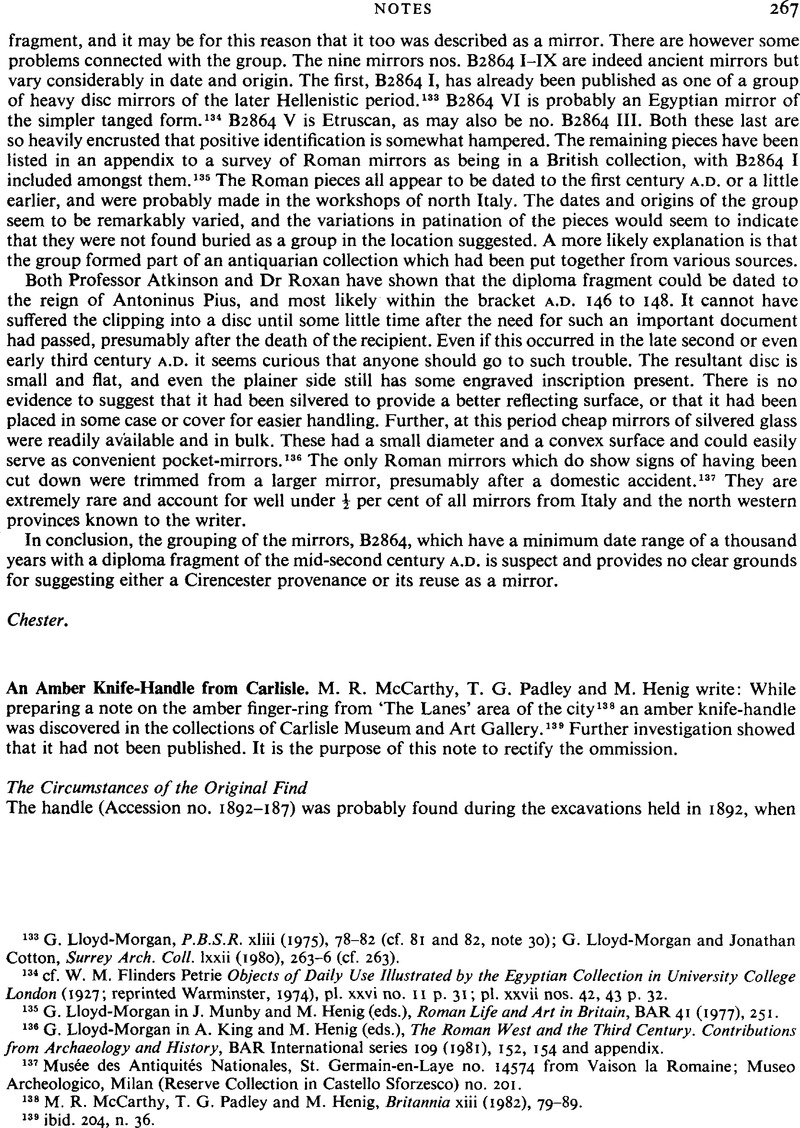Article contents
An Amber Knife-Handle from Carlisle
Published online by Cambridge University Press: 09 November 2011
Abstract

- Type
- Notes
- Information
- Copyright
- Copyright © M. R. McCarthy, T. G. Padley and M. Henig 1983. Exclusive Licence to Publish: The Society for the Promotion of Roman Studies
References
138 McCarthy, M. R., Padley, T. G. and Henig, M., Britannia xiii (1982), 79–89.CrossRefGoogle Scholar
139 Ibid. 204, n. 36.
140 The published account of the excavation, Ferguson, R. S., ‘On a Massive Timber Platform of early date uncovered at Carlisle: and on sundry relics found therewith’, Trans. Cumbd Westmd Antiq. Arch. Soc. O.ser. xii (1893), 344–364, does not mention the object. There is a handwritten list of finds in the museum's archives, MS.CAT. 6, but objects with numbers higher than 160 are in a different handwriting from those with lower ones. The reason for attributing the handle to this excavation is that there is a gloss in the manuscript catalogue in the same hand as the entries with numbers higher than 160 which says, ‘Articles from 160 are not included in Chancellor Ferguson's catalogue but were placed by him in the Tullie House case’. Further evidence for this attribution is that the coins mentioned in the published report are not on the original list, but have been added in the second handwriting, and have numbers higher than 160.Google Scholar
141 Unfortunately, the object has suffered slight damage to the perforation after the drawing was made.
142 Pliny, , N.H. xxxvii, 30: in sucinis causam ne deliciae quidem adhuc excogitare potuerunt.Google Scholar
143 Buchem, H. J. H. van, Numaga xxi (1975), 213Google Scholar fig. 6. Others from Heerlen show a cupid (Ibid. fig. 5) and a grasshopper (Ibid., 214 fig. 7); one from Nijmegen depicts a recumbent hound (Ibid. 212 fig. 4); a handle found at Cologne is cut in the form of a Victory (Baume, P. La in Claus, M., Haarnagel, W. and Raddatz, K., Studien zur europäischen Vor- und Frühgeschichte (Neumünster, 1968), 108, no. 1, pl. 8, 2.Google Scholar
144 Berti, F., Aquileia Nostra 1 (1979), 315 nos. 20–3, fig. 1.Google Scholar
145 R. C. H. M. Eburacum (London, 1962), 100, pl. 34; Henig, M., A Corpus of Roman Engraved Gemstones from British Sites BAR 8, second edn. (1978), 102 and 235 no. 392, pl. xiii.Google ScholarBarb, A. A., Journ. Courtauld and Warburg xvi (1953), 204–8;Google ScholarToynbee, J. M. C., Animals in Roman Life and Art (London, 1973) 203–4, also 202 (on hares ‘as a symbol of after-life fertility’);Google ScholarFurtwängler, A., Königliche Museen zu Berlin. Beschreibung der Geschnittenen Steine im Antiquarium (Berlin, 1896) 314 no. 8576 pl. 61 and 305 nos. 8321, 8322 pl. 60;Google ScholarPanofka, T., Gemmen mit Inschriften (Berlin, 1852) 89–90 no. 108 pl. iii, 12. MNHCΘH ΘEOΓENEIC.Google Scholar
146 Bertacchi, L., Aquileia Nostra xxxv, 1964, 51–75.Google Scholar
- 2
- Cited by


